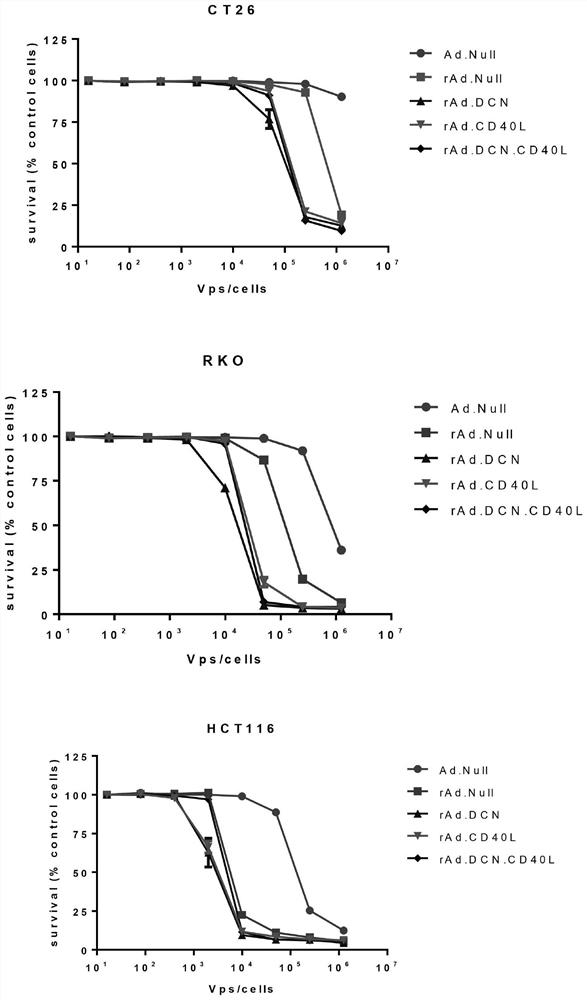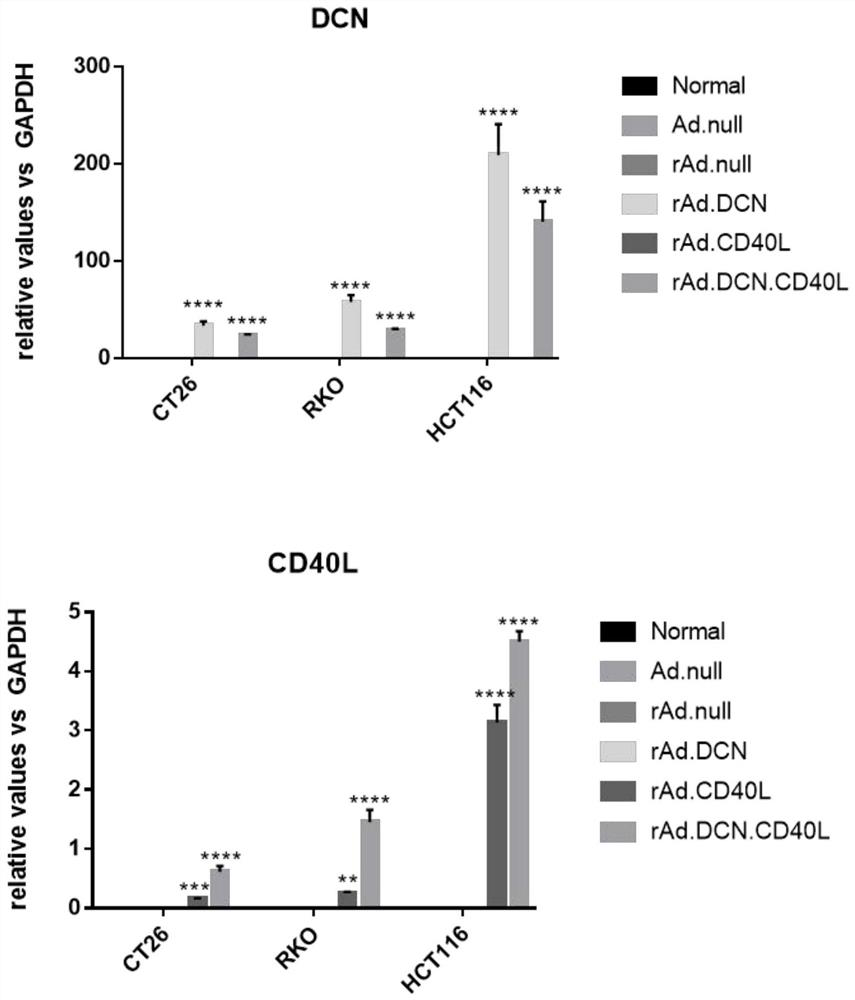Multi-gene fusion oncolytic adenovirus and construction method and application thereof
An oncolytic adenovirus and multi-gene technology, which is applied in the field of multi-gene fusion oncolytic adenovirus and its construction, can solve the problem that the efficiency of tumor-specific promoters cannot meet expectations, and can improve the tumor immune microenvironment and activate the body. The effect of anti-tumor immune response, promoting tumor cell apoptosis, and improving the level of treatment
- Summary
- Abstract
- Description
- Claims
- Application Information
AI Technical Summary
Problems solved by technology
Method used
Image
Examples
Embodiment 1
[0053] Example 1 Construction and preparation of recombinant adenovirus rAd.DCN.CD40L
[0054] The method is to synthesize DCN gene (decorin gene) and CD40L gene, insert DCN into pshuttle-cmv vector to obtain pShuttle-cmv-DCN (pSh.cmv.DCN); Viral E1A gene, natural E1B promoter, CD40L gene, internal ribosomal entry site (IRES) and E1B55K are connected in sequence, cloned into TE vector to obtain TE-TP-E1A-CD40L, and digested with restriction endonuclease MfeI TE-TP-E1A-CD40L, obtain the replication-related genes, clone them into the corresponding site of pSh.cmv.DCN, and obtain the shuttle plasmid pSh.cmv.DCN.CD40L.RE; refer to the Adeasy system to obtain the recombinant adenovirus plasmid pAd .DCN.CD40L.RE; and the oncolytic adenovirus rAd.DCN.CD40L was prepared in HEK293 cells. Specifically:
[0055] (1) Construction of pSh.cmv.DCN
[0056] Synthesize the full sequence of the DCN gene (as shown in Table 1) by gene synthesis technology, and add SalI and XhoI enzyme cutting ...
Embodiment 2
[0070] Example 2 In vitro function verification of oncolytic adenovirus rAd.DCN.CD40L
[0071] The method is, in colorectal cancer cells, using sulforhodamine B (SRB) staining method to detect the killing effect of oncolytic virus; through fluorescent quantitative detection of target genes DCN and CD40L in colorectal cancer cells Express. Specifically:
[0072] (1) Detection of killing ability of oncolytic adenovirus rAd.DCN.CD40L
[0073] Human colorectal cancer cell lines RKO, HCT116 and mouse colorectal cancer cell line CT26 were divided into 1×10 3Cells / well were seeded in 96-well plates. The next day, the oncolytic adenovirus rAd.DCN.CD40L and the control virus rAd.Null, rAd.DCN, rAd.CD40L and Ad.Null were respectively infected with 5-fold serial dilutions (1.25×10 6 Vps / cell-80Vps / cell). On the seventh day (sixth day after infection), SRB staining was used to detect the survival rate of the cells in each well, so as to clarify the cell killing effect of the oncolyti...
Embodiment 3
[0076] Example 3 Evaluation of curative effect of oncolytic adenovirus rAd.DCN.CD40L on colorectal cancer xenografts in mice
[0077] The method is to use mouse colorectal cancer cell CT26 to establish a transplanted tumor model, administer oncolytic virus intratumorally for treatment, and monitor its growth to evaluate the effect of oncolytic virus on mouse colorectal cancer transplanted tumors. Therapeutic effect. Specifically:
[0078] Single cell suspension of mouse colorectal cancer cells in 2×10 6 Cells / mouse, Babl / c mice subcutaneously bearing tumors for 6-8 weeks, observe the growth of tumors, detect the volume of tumors 7 days after tumor bearing, and randomly divide them into Buffer group and rAd. Null group, rAd.DCN, rAd.CD40L and rAd.DCN.CD40L groups. According to 2.5×10 10 VPs / 100μl dose, intratumoral injection of recombinant adenovirus for treatment. After treatment, the health status of the mice and the growth volume of the tumor were observed. The experim...
PUM
 Login to View More
Login to View More Abstract
Description
Claims
Application Information
 Login to View More
Login to View More - R&D
- Intellectual Property
- Life Sciences
- Materials
- Tech Scout
- Unparalleled Data Quality
- Higher Quality Content
- 60% Fewer Hallucinations
Browse by: Latest US Patents, China's latest patents, Technical Efficacy Thesaurus, Application Domain, Technology Topic, Popular Technical Reports.
© 2025 PatSnap. All rights reserved.Legal|Privacy policy|Modern Slavery Act Transparency Statement|Sitemap|About US| Contact US: help@patsnap.com



